Average home insurance rates are rising faster than inflation — and they're not likely to slow down

Average home insurance costs rose 11.4% between 2017 and 2020, outpacing inflation and driving up the price of homeownership for Americans across the country. (iStock)
The average cost of home insurance is rising at a faster rate than inflation, and consumers should expect this trend to continue into the new year.
Annual homeowners insurance premiums rose 11.4% between 2017 and 2020, according to S&P Global Market Intelligence. During that same time period, inflation rose 5.6% per the Consumer Price Index (CPI).
This added expense comes at a time when homeownership is already becoming more out-of-reach for many Americans, as home prices surge and mortgage rates are expected to rise in 2022.
Keep reading to learn more about what's causing home insurance premiums to rise, as well as tips for keeping your rates low. You can shop around for free homeowners insurance quotes on Credible.
HAVE BAD CREDIT? YOU MIGHT BE OVERPAYING FOR HOMEOWNERS INSURANCE
Why is the average cost of homeowners insurance rising?
The average homeowners insurance cost rose to an all-time high last year to $1,398 annually, according to the Insurance Information Institute (Triple-I).
Growing home insurance premiums are due to a few factors, including "the frequency and severity of natural disasters over the past few years coupled with rising costs of items that go into rebuilding damaged homes," said Michael Barry, chief communications officer at Triple-I.
- Michael Barry, chief communications officer, Triple-I
IS TORNADO DAMAGE COVERED BY MY HOMEOWNERS INSURANCE POLICY?
Barry added that "rates are based on the actual and anticipated losses in each state," which have been difficult to predict over the past few years. The 2020-21 hurricane season resulted in record-high losses in coastal states like Louisiana and Florida. Other unexpected disasters included the February 2021 freeze in Texas and the recent Colorado wildfires.
In addition, the cost of post-disaster recovery is higher than ever. The price of labor skyrocketed during the coronavirus pandemic while the cost of materials like lumber continue to rise amid supply chain disruptions. This drives up replacement costs, which means that insurance companies are paying out larger claims.
Higher claim amounts impact the insurer's combined ratio, which is the amount they pay out in claims for every dollar collected worth of premiums. Even with rising average annual premiums, home insurance companies have been struggling to keep up their combined ratio at a sustainable level over the past several years, Barry said. This means insurers may need to continue rate hikes just to keep up with operating costs.
You can learn more about how home insurance premiums are determined on Credible.
HERE'S WHERE FLOOD INSURANCE PREMIUMS ARE RISING THE MOST
How to keep your homeowners insurance costs low
With average premiums expected to continue rising, it's up to consumers to find the opportunity to save on their home insurance costs. Here are a few ways to find a lower insurance premium, according to Triple-I:
- Opt for a policy with a higher deductible. Your home insurance deductible is the amount of money you have to pay before your insurance company starts to pay toward a claim. Raising your deductible by $1,000 may be able to save you as much as 25% on your premium. Higher deductibles will result in lower monthly rates, but you'll have to pay more out-of-pocket in the event of an accident.
- Bundle your insurance policies. Companies that offer home insurance policies, liability coverage and auto insurance may offer discounts ranging between 5% and 15% if you purchase multiple policies through them.
- Seek out home insurance discounts. Homeowners may be eligible for insurance discounts based on their age, employment status and even credit score. For example, retired homeowners ages 55 and up may qualify for a discount worth up to 10% through some companies.
- Retrofit your home. You may be able to lower your home insurance premiums by making your home more disaster-resistant with storm shutters and stronger roofing materials. Updating your heating, plumbing and electrical systems can reduce the risk of water and fire damage. Finally, installing a sophisticated sprinkler system or burglar alarm if you live in an area with high crime rates may cut your premium by as much as 20%.
- Shop around across home insurance companies. Insurers set rates based on a number of factors, and the premium you can qualify for may vary from one insurance company to another. "The beginning of the year is a good time to shop around and see that you’re getting the best deal," Barry said.
Shopping around may be able to save you hundreds of dollars per year on your premiums. You can compare home insurance quotes across multiple insurers for free on Credible.
YOU MAY BE DENIED HOME INSURANCE COVERAGE IF YOU HAVE ONE OF THESE 10 DOG BREEDS
Have a finance-related question, but don't know who to ask? Email The Credible Money Expert at moneyexpert@credible.com and your question might be answered by Credible in our Money Expert column.

